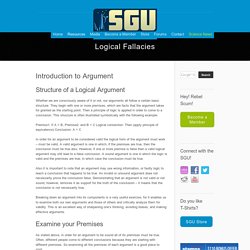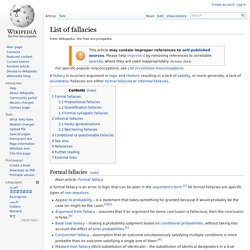

Critical thinking. Top 20 Logical Fallacies - The Skeptics' Guide to the Universe. Introduction to Argument Structure of a Logical Argument Whether we are consciously aware of it or not, our arguments all follow a certain basic structure.

They begin with one or more premises, which are facts that the argument takes for granted as the starting point. Then a principle of logic is applied in order to come to a conclusion. This structure is often illustrated symbolically with the following example: Premise1: If A = B, Premise2: and B = C Logical connection: Then (apply principle of equivalence) Conclusion: A = C In order for an argument to be considered valid the logical form of the argument must work – must be valid. Also it is important to note that an argument may use wrong information, or faulty logic to reach a conclusion that happens to be true.
Breaking down an argument into its components is a very useful exercise, for it enables us to examine both our own arguments and those of others and critically analyze them for validity. Examine your Premises Ad hominem Straw Man. Logical Flaws in Reasoning: Flawed Reasoning, Arguments, and Attitudes. When a person's argument is flawed, usually those flaws can be traced back to identifiable fallacies.

Not all flaws, however, can be technically labeled as fallacies. Some of these flaws might represent very specific errors in the reasoning process while others are better described as flaws in a person's attitude or how they approach the subject matter generally. Barnum Effect & GullibilityA common reference point as to why people believe the advice of psychics and astrologers - not to mention many other nice things said about them - is the 'Barnum Effect.' Named after P.T. Barnum, the Barnum Effect is based upon his famous saying 'There's a sucker born every minute.' Black & White ThinkingHuman beings have a need to categorize everything; this is not a fault but rather an asset.
Excess VerbiageThis is less a flaw in the reasoning process than a flaw in the argument or deliberation process. List of fallacies. A fallacy is incorrect argument in logic and rhetoric resulting in a lack of validity, or more generally, a lack of soundness.

Fallacies are either formal fallacies or informal fallacies. Formal fallacies[edit] Main article: Formal fallacy Appeal to probability – is a statement that takes something for granted because it would probably be the case (or might be the case).[2][3]Argument from fallacy – assumes that if an argument for some conclusion is fallacious, then the conclusion is false.Base rate fallacy – making a probability judgment based on conditional probabilities, without taking into account the effect of prior probabilities.[5]Conjunction fallacy – assumption that an outcome simultaneously satisfying multiple conditions is more probable than an outcome satisfying a single one of them.[6]Masked man fallacy (illicit substitution of identicals) – the substitution of identical designators in a true statement can lead to a false one. Propositional fallacies[edit] Fallacies. Dr.

Michael C. Labossiere, the author of a Macintosh tutorial named Fallacy Tutorial Pro 3.0, has kindly agreed to allow the text of his work to appear on the Nizkor site, as a Nizkor Feature. It remains © Copyright 1995 Michael C. Labossiere, with distribution restrictions -- please see our copyright notice. If you have questions or comments about this work, please direct them both to the Nizkor webmasters (webmaster@nizkor.org) and to Dr. Other sites that list and explain fallacies include: Constructing a Logical Argument Description of Fallacies In order to understand what a fallacy is, one must understand what an argument is. There are two main types of arguments: deductive and inductive.
A fallacy is, very generally, an error in reasoning. Logical Fallacies.